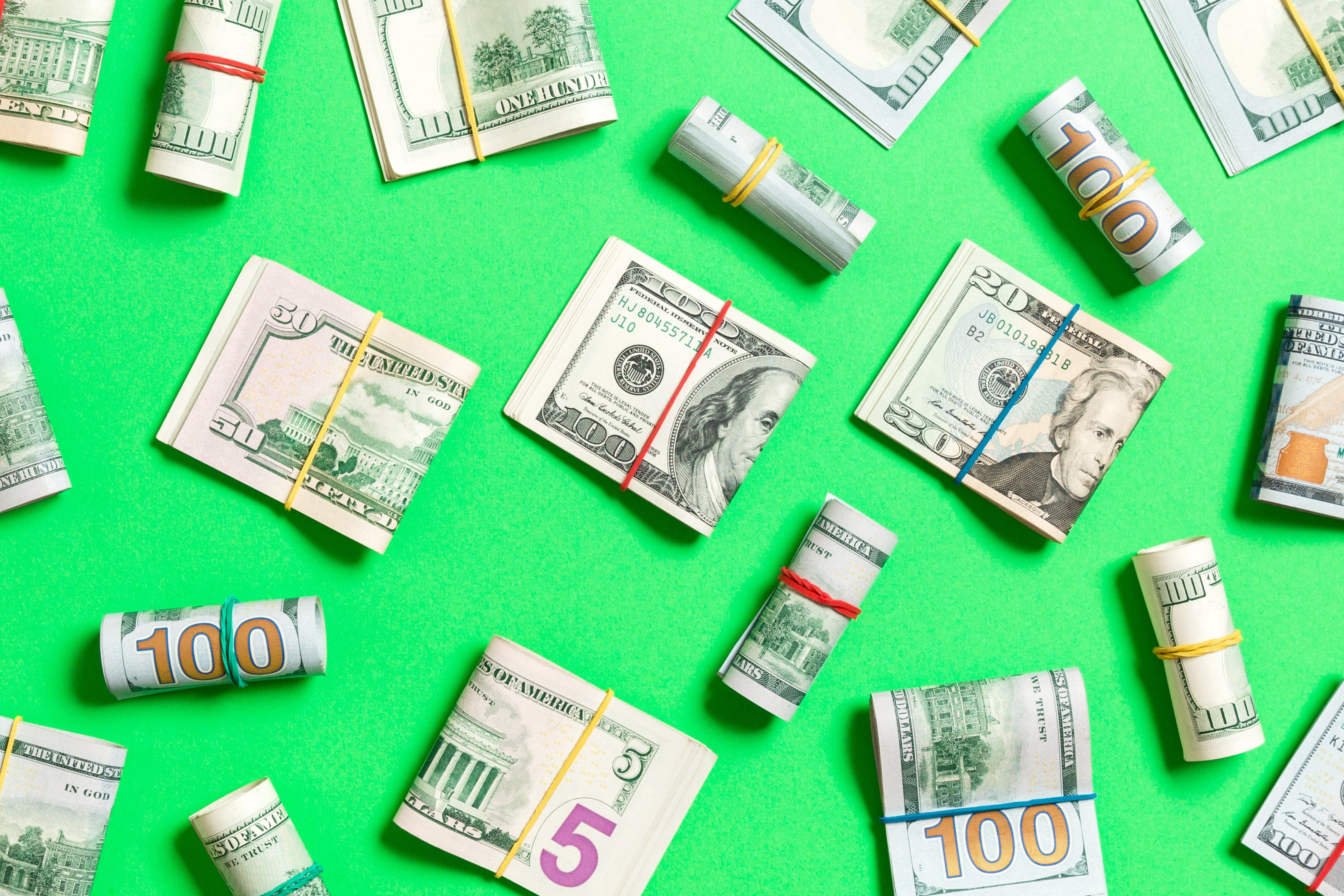Article #4 in this Hi-Output Wealth Series.
Introduction
In a recent study conducted by Forbes, 49% of Americans are using Debit Cards to conduct their daily transactions.

Many of these individuals have been scared off by the fear of accumulating credit card debt and by the various headlines that surround credit card usage.

And to make matters worse, as of Q2 2023, U.S. Consumer Credit Card debt passed $1 Trillion dollars, roughly $7,925 per household. A value that has been rising since closures from the pandemic tapered off and a historically high number.

A number of mainstream outlets, of course, have raised the alarm, but when we consider the data the reality is far less concerning. As it turns out, the ratio between credit card debt and personal income (a much clearer indication of consumer experience), Americans are doing much better (pandemic excluded) with lower rates of credit card debt than we have in the last twenty years.

In same way that $1 trillion in debt obscures the fact that credit card debt as a ration of personal income is at it's lowest levels in the last twenty years, so too can the fear of credit card debt obscure the true value of owning and using a credit card. In this article we are going to cover everything you need to know about credit cards:
- Why Credit Cards are Superior to Debit Cards
- How to Select the Right Credit Card for You
- How to Set Up Your Card to Work for You
- How to Avoid Paying Extra to the Credit Card Company
- How to Maximize Your Rewards Points
Collectively these strategies, data points, and tips will enable you to get the most out of this important financial tool, accelerating your accumulation of wealth and potentially transforming your life.
1. Why Credit Cards are Superior to Debit Cards
Today there are a number of Tik Tok and other financial trends (ie. cash stuffing) that point consumers to using cash or debit cards. This is a waste of time. If you qualify for a credit card, you should be using one. The following table outlines why:
|
Credit Card |
Debit Card (or Cash) |
|
Limited Liability: It provides an additional layer of security between your cash and the businesses you transact with. (ie. Didn’t make a purchase, just dispute it.) |
Full Liability: You are liable for any money that is willfully or unwillfully drawn from your bank account. |
|
Predictability: Predictable bill paying schedule. |
Immediate: Any charge that comes in must be paid immediately. |
|
Flexible Short Term Loans: Credit cards provide you with the ability to delay your purchase past the purchase date or bill date so that you can buy yourself some more time or pay for something now even if you don't have the money. |
No Loans: By definition you are unable to extend the period you owe a debt by any more than a few days and need to have the funds immediately available for purchase. |
|
Rewards: Rewards cards generally give users about 1-5% cashback on purchases. |
No rewards: Banks provide nothing in exchange for using debit cards. |
|
Build Credit: In today’s economy, a large number of transactions (car sales, home sales, business loans, etc.) are predicated on the consumer paying back the business over time (think a car loan). Using a credit card allows you to establish data points that you are capable of repaying a loan consistently, which builds your credit score and gives companies confidence that you will pay them back too. |
No Credit: Because there is no borrowing with use of a debit card, there is no opportunity to build your credit. Meaning that loan companies have far less data to determine the likelihood of you repaying a loan. |
Consumers that are using cash or debit cards to transact are increasing their personal financial liability, forgoing 1-5% cashback, and are likely forcing themselves into non-optimal purchasing decisions due to the lack of flexibility with these payment options. If you are concerned about amassing credit card debt, all you need to do is pay your bills in full each month and you have no chance of accumulating debt.
2. How to Select the Right Credit Card for You [Template Included]
The hardest thing about choosing the right credit card is being able to decipher all of the financial jargon that surrounds selecting one and being able to model whether the card makes financial sense for you. Fortunately for you, we will help you understand the key terms as well as provide you with a template to calculate which credit card saves you the most.
Below are a few key terms and a brief explanation of what they are:
- Introductory Offers - The offer that credit cards provide the user to encourage them to sign up. This can come in the form of points or cash. (Ex. 200,000 bonus points or $250 cashback.) These offers can change significantly over time and can often be solicited by picking up the phone and talking to a credit card rep.
- Continuous Rewards Offers - The per transaction rewards offer. For example, 2% cash back or 2x points etc. This is an important input in the value of the credit card as providing high rewards on items that you don’t spend on isn’t particularly useful. You should think of the value of these offers as ranging from 1-5% cash back.
- Annual Fees - The total annual cost of owning the card as charged annually by the credit card company. This can and often does go up marginally over time, so be conscious and aware of this over the years of owning a card, generally this is communicated prior to the change, but it is always important to keep an eye out especially for the magnitude of the change as this can change your ownership calculus over time. For non-rewards cards the annual fee is generally zero.
- APR - Annual Percentage Rate - This is the annual rate that credit card companies charge consumers unpaid debts. The higher the rate the higher the cost of your unpaid debts. This calculation only comes into play if you allow your balance to go unpaid beyond the planned billing period (usually about a month).
In order to determine the value of a credit card for your own consumption you need to understand a few elements: your expected spend, the introductory offer, the continuous offer, annual fees, and the credit card's APR. Generally speaking, you should always open a credit card with the expectation that you will pay your monthly bill in full each month, for this reason let’s set aside credit card APR for now and consider the following calculation(s):
First Year Credit Card Value = Introductory Offer + [Expected Annual Spend x (% Cash Back)] - Annual Fees
Steady State Credit Card Value (No Intro Offer) = [Expected Annual Spend x (% Cash Back)] - Annual Fees
In essence, the value of a credit card is the difference between the value it generates for you minus it's cost. In order to find the best card, we need to find the card that maximizes the difference between the value the card provides us (incentives and offers) net of the annual fees that are charged given our level of spend.
Ignore anyone that says rewards cards are not worth it or no fee cards are too cheap, this is inherently a personal calculation for each consumer. The answer may be different across different consumers and different cards.
To help you calculate these values for even more complicated scenarios we created this free spreadsheet that does the heavy lifting for you. In it, we provide reference numbers for your calculations and again handle all the calculations. All you need to do is find the blue highlighted values for each of the credit cards you want to compare and select the one with the highest savings rate. All the figures should be easily found in the introductory documentation for the card you are expecting to open, from your personal files, or online.
To give you the hang of it let’s walk through a simplified calculation (no intro offer included), for argument sake, I will use my own credit card statement figures:
- Monthly Spend (yearly, x12) = $2,331 ($27,972)
- Monthly Rewards Points = 5,361
- Redeemed Dollars per Rewards Point = 1.52 cents
- Rough Cash Back per Dollar = (Rewards Points / Monthly Spend) x Monetary Value of Single Point = (5,361/2,331) x 1.52 = ~3.5 cents or 3.5% cash back
- Credit Card Savings: [Expected Annual Spend x (% Cash Back)] - Annual Fees
- Credit Card Savings: ($27,972 x 3.5%) - $550 = $429 or 1.5% savings rate
This simple example shows us that even a high fee card ($550 Annually) can generate meaningful savings ($429 Annually). This example along debunks the belief that all high fee cards are inherently bad. In order to find the best card for you, you just have to compare this credit card savings number to find the card that saves the most.
Important Tip: If you are wondering where to find different credit card options for this comparison, check out NerdWallet for more information on top cards and the latest offers to begin to familiarize yourself with the different options.
3. How to Set Up Your Card to Work for You
Once you choose your credit card, you want to ensure that your credit card is working for you, limiting your headaches and minimizing your financial mistakes. Below are some basic strategies and tips that will help you to manage your finances, stay out of debt, and reduce the anxiety of paying your monthly bills:
- Limit the number of credit card accounts you spend from - Minimize the financial complexity in your life by reducing the number of credit cards you use. Many people like chasing credit card introductory offers, in most cases the added complexity will lead to overspending or late payments which will cancel out the marginal benefit of that new card. Keep it simple, start with one, and carefully weigh the benefits of opening a new card to ensure it outweighs the risk.
- Use One Checking Account for Income and Expenses - One of the most important things to avoid in your personal finances is having to unnecessarily move money around among accounts to pay bills. This can result in additional stress that can be completely eliminated. Prevent this from happening by ensuring that your income and your expenses are linked to the same bank checking account. Either automate or manually set aside your savings in the savings account.
- Customize the timing of your credit card bills - One of the frustrating things about managing your finances month to month is the fact that income doesn’t always align with your bill due dates. Instead of scrambling for cash, you can actually adjust the day of the month that your credit card bill is due. In this way, you can time your bill to fall after a paycheck. Assuming you are paid biweekly and pay monthly for housing, a good time to schedule this due after you have collected your second paycheck and after you pay your housing bills, think the 9th of the month. The increases the likelihood that you are going to have enough cash to cover your most timely bills and positions you with enough time and flexibility to cover the remaining ones.
- Set Limits on Your Monthly Spend - Perhaps the most useful step for those that fear overspending on their credit card, some credit card companies allow consumers to set their own spending limits. Simply access your profile settings and adjust the value that you would not like to exceed, for participating credit card companies see this Nerd Wallet article.
With these three simple steps you will be be able to significantly reduce the complexity of using your credit card, which will very like you save money (and the very least time) in the long run.
4. How to Avoid Paying Extra to the Credit Card Company
One of the most polarizing characteristics of credit cards is that they provide you with the ability to spend money you don’t have, enabling you to accumulate debt. This paired with eye watering interest rates (ie. APR’s) can lead consumers to accumulate significant sums of debt that are very hard to pay back.
The obvious remedy to this scenario is simply to pay your bills in full each month. If your able to cover your expenses you will never have to worry about accumulating debt or APR’s for that matter. But just to pressure test, let's consider the scenario where you do accumulate debt, to show you that unwinding credit card debt is relatively doable so long as you are financially responsible.
Let’s first acknowledge that the accumulation of debt in extreme cases is bad for credit card companies due to the simple fact that the credit card company is liable for the debt that you accumulate, they effectively cover your expenses in the case that you don’t. Operating on this general principle credit card companies do put guardrails in place to prevent these extreme scenarios, it’s called a credit limit.
- Credit Limit - they limit the balance of your credit card which effectively caps the amount of money that you can spend in any given month and caps that amount of spend you can accumulate without playing your bills. Many cards for example don’t allow you to spend over ten thousand dollars and only increase your credit limit as you spend more money. This is primarily to prevent fraud or thieves from opening accounts spending a ton of money and walking away, but does have a practical application if in a particular month you spend far too much.
Further, some credit card companies even allow you to set self-prescribed limits on the amount that you spend, if you are concerned about over spending as we described above.
Generally though, we also need to acknowledge that credit card companies do make a considerable amount of money from consumers by charging their consumer’s interest. The vast majority of these consumers who for whatever reason are unable to pay their bills in full and accumulate debt, for which the credit card companies charge a daily interest rate (often communicated as an Annual Percentage Rate or APR). This rate can measure as high as 29% annually (in the simplest scenario you will have to pay 1.29x your outstanding balance, $1,290 if your balance is $1,000.
In order to prevent this scenario you need to ensure that you are paying each month in full and not carrying a balance (unpaid bills month to month) or at the very least paying down your outstanding balance as quickly as possible. In order to visualize the additional costs that are accrued due to interest, reference the below visual:
 Assuming $2,000 in monthly credit card spend, we can clearly see that the worst thing that you can do as a credit card consumer is to only pay off the minimum required payment. Whether ethical or not, the credit card company will allow you to keep using the card (ie. be in good standing) but you will owe the maximum amount in interest payments. In this case, over a three year period, you would owe an additional $34,267 on top of the value of the items that you purchased. Leading you to spend 47.6% more than if you had paid your bills in full. This number of course would increase over time, if you maintained the same behavior.
Assuming $2,000 in monthly credit card spend, we can clearly see that the worst thing that you can do as a credit card consumer is to only pay off the minimum required payment. Whether ethical or not, the credit card company will allow you to keep using the card (ie. be in good standing) but you will owe the maximum amount in interest payments. In this case, over a three year period, you would owe an additional $34,267 on top of the value of the items that you purchased. Leading you to spend 47.6% more than if you had paid your bills in full. This number of course would increase over time, if you maintained the same behavior.
The strategic insight that we learn from the visual is that as long as you pay a large portion of your outstanding balance you can keep your payments due to interest far lower (0.8% vs. 47.6%) and much more manageable. It is not that a single month’s missed payment or a balance not paid 100% in full leads to inescapable credit card debt. This is generally something that happens over months of paying a small portion of your overall credit card balance.
If you would like to measure this scenario for yourself, to understand how this calculation works for your particular situation we have created this free Google Sheets template to test different scenarios.
Hopefully, this example helps demonstrate that if you pay your credit card in full or quickly payback any shortfall there is nothing to worry about.
5. How to Understand and Maximize your Rewards Points
The most exciting feature of rewards cards are the rewards points that consumers generate. Virtually all companies market compelling introductory offers and point multipliers that give consumers the impression that they are saving great sums of money but as we demonstrated in the previous sections you generally have to spend great sums of money to generate great sums of credit card points. For every dollar you spend you can only expect to get 1 to 5 cents back at most. This highlights the important point that the best way to save on your credit card is not to spend it in the first place. However, in the spirit of this section, let’s consider how to maximize our rewards points. In order to do this let’s split the conversation into two distinct categories:
- Reward Point Accumulation - the act of accumulating points by spending your money
- Reward Point Redemption - the act of redeeming your points for perks, rewards, or cash equivalents
Reward Point Accumulation:
As we mentioned earlier in this article your categories of spend are often associated with different rewards point accumulation rates or savings rates. For example some cards give higher points back for Gas or Groceries. This is important to know when selecting a card as we mentioned, if groceries are your largest expense then a rewards card that provides you with the highest savings rate for these types of purchases becomes a compelling offer. However, once you have selected a credit card it is easiest to simply forget about the purchases that generate the most points. Doing so will prevent you from justifying more spending than you need. Getting double points sounds like a reasonable justification to buy two pints of ice cream instead of one, leading to $10 more in spend for $0.05 cents in rewards. Generally speaking, you should not be putting much effort into trying to accumulate more points.
Reward Point Redemption:
As far as redemption is concerned not all redemption is created equal; each category of spend generally coincides with its own redemption rates which we are measuring here as $ per point. This can be easily calculated by dividing the $ value of your points by the number of points that you are able to redeem. (In this table, Chase provides me with bonus points for experiences which is why the point total is higher.) The following table outlines Chase’s current (August 2023) point redemption values.
|
Chase Reference Points Table |
Points |
$ Value (Provided by Chase) |
$ per point |
|
Flights |
19,476 |
$291.14 |
$0.015 |
|
Cash back |
19,476 |
$194.76 |
$0.010 |
|
Amazon |
19,476 |
$155.81 |
$0.008 |
|
Pay Yourself Back |
19,476 |
$292.14 |
$0.015 |
|
Experiences |
25,000 |
$250.00 |
$0.010 |
Generally speaking, the highest point redemption rates can be found on Travel (primarily because those who do tend to spend more to offset the additional rewards costs) while deals with Amazon and Apple tend to return the lowest $ per point. These can change over time so make sure to check your credit card providers redemption rates. Despite the variation in $ per point you can see that the variation is relatively small in absolute (fractions of a cent in some cases), this creates some level of indifference for the consumer. Take for example the largest delta Flights and Amazon, a difference of $135, this delta generally shouldn’t incentivize the creation of a new trip but similar to point accumulation the rewards are likely best used on an already planned one. Rewards points are in general the most valuable when used on necessary spend and not incremental purchases. All things considered equal, however, you should always be redeeming your points on the items that give you the highest $ per point.
Conclusion
In this article, we have covered a large number of credit card topics spanning the following five categories:
- Why Credit Cards are Superior to Debit Cards
- How to Select the Right Credit Card for You
- How to Set Up Your Card to Work for You
- How to Avoid Paying Extra to the Credit Card Company
- How to Maximize Your Rewards Points
In these sections, we have provided general strategies, tips, data, and even templates to facilitate your adoption and effective usage of this important financial tool. Hopefully, over the course of this article you have developed a higher level of confidence in the value of credit cards and your own willingness and ability to use one effectively.
Thanks for reading! Reach out with feedback or requests via our Contact Us link or look us up on social media @hioutput_data.
Don’t forget to check out our performance enhancing digital products to accelerate your progress.





Leave a comment
All comments are moderated before being published.
This site is protected by hCaptcha and the hCaptcha Privacy Policy and Terms of Service apply.